On April 9th, 1940, Hitler unleashed his military machine on Norway, breaking that country's neutrality and overwhelming the unprepared defenders at cities including Oslo, Kristiansand, Stavangar and Bergen using troops carried aboard warships. Offshore, the British fleet was in the North Sea, but they had missed even the task forces headed for the northernmost cities, such as Trondheim and Narvik.
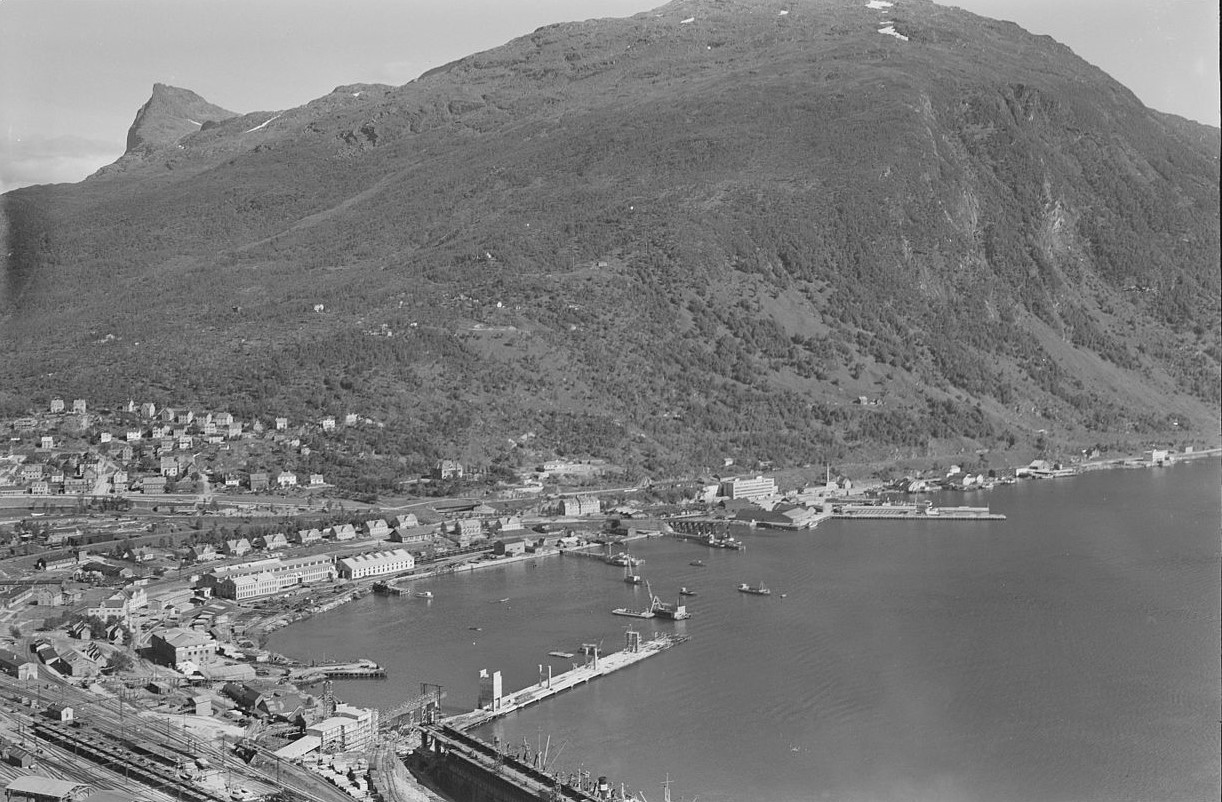
Narvik in the 1940s
Narvik, 200 kilometers north of the Arctic Circle, was one of Norway's busiest ports, the terminus for a railroad bringing iron ore from Sweden. When the Baltic froze in the winter, it was the only link from the mines to the outside world, and the city had grown rapidly to support the shipping in the area. Because it had been a tiny village of a few hundred people in the 1890s, when Norway's coastal defenses were built, it had not made the list, and while work on fortifications had started in 1914, it had been shelved postwar and never restarted. In the early months of 1940, Narvik had been the center of a great deal of diplomatic maneuvering, as the Allies tried to cut iron ore exports to Germany and use the railroad to reinforce Finland, under assault from the Soviets. That plan had been abandoned, and the British didn't actually take action until April 8th, when they laid mines on the Norwegian coast in an attempt to interdict traffic to Narvik.
This served as a wakeup call to what defenses Narvik did have. Two panserskip, 40-year-old coastal defense ships, were stationed there, each armed with 2 21 cm and 6 15 cm guns. They were backed up by two submarines, a tender, and a trio of auxiliaries. Reports of the mines prompted the Norwegian commander to order a heightened alert, compounded by fears of a British raid on the German ships in Narvik harbor. But it wasn't the British they would have to deal with. 10 German destroyers were bearing down on them after a truly brutal passage through a storm in the Norwegian Sea, loaded with 200 or so mountain troops each and with bunkers almost empty. Before they arrived, reports began to trickle in from the south, describing the German attacks on Oslo, Bergen and Trondheim. The company of troops in the city was ordered to prepare to fight, and the rest of the battalion was ordered to join them from Elvegardsmoen Barracks on the fjord nearby. Eidsvold, one of the panserskip, was stationed outside the entrance to the harbor, while the other, Norge, remained behind where it had a telephone connection to headquarters ashore.
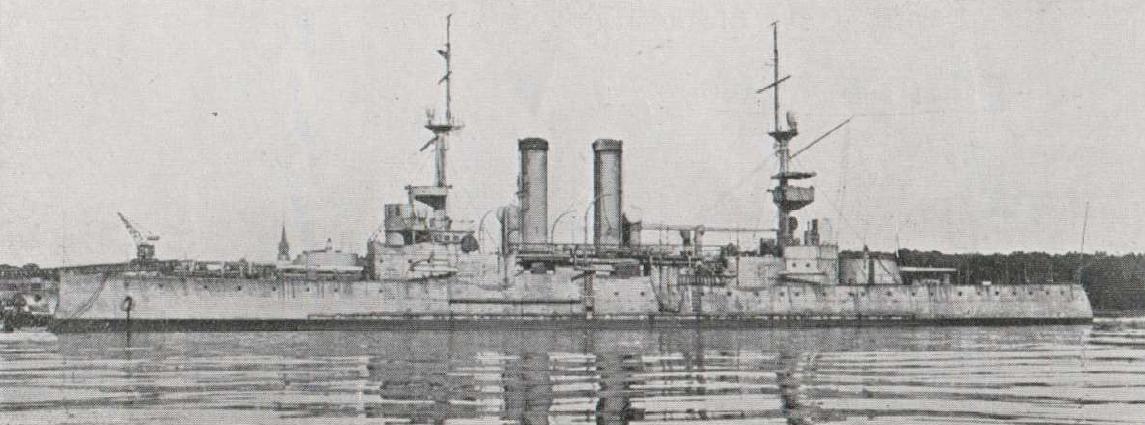
Norge in 1933
Hopefully, both ships would have sufficient warning of the German's arrival, thanks to the auxiliaries Michael Sars and Kelt, patrolling at the mouth of the Ofotfjord, 50 km to the west of Narvik. The entrance was narrow, and despite the driving snow, they could clearly see nine ships1 passing them at 0310, which they identified as German destroyers. Word was swiftly radioed back to the panserskip, and both ships went to battle stations while Norge moved to cover the mouth of the harbor. Six of the nine destroyers quickly peeled off to capture installations around Narvik. Three were detailed to seize the forts that German intelligence for some reason believed guarded the Ofotfjord, while troops from the other three would secure Elvegardsmoen Barracks. The first group found themselves wandering in the snow, looking for emplacements that weren't there, while the second group easily overran the empty barracks.
At 0415, Eidsvold spotted the first intruders appearing out of the snow, a bare 400 meters away. She challenged them via light, but was ignored until a warning shot from one of her 76mm guns got their attention. Heidkamp, the German flagship, slowed and signaled that she was sending an officer over while her two consorts continued towards Narvik. Eidsvold's captain refused to budge from his orders to defend the city, and sent the German officer back. As the boat returned to the German destroyer, the two sides were in a tense standoff. The Germans were under clear orders not to open fire first, but if Eidsvold did open fire, she would find it hard to miss, and her battery would do grievous damage to the unarmored destroyer and the troops aboard her. Eventually, the concerns of the ground commander prevailed, and she fired her torpedoes at the Norwegian vessel. The Norwegians, probably out of a sense of chivalry, waited a bit too long, and just as the order to open fire was passed, the torpedoes struck. They instantly shattered the ancient panserskip, setting off the magazines and taking 177 of the 185 aboard down with her.
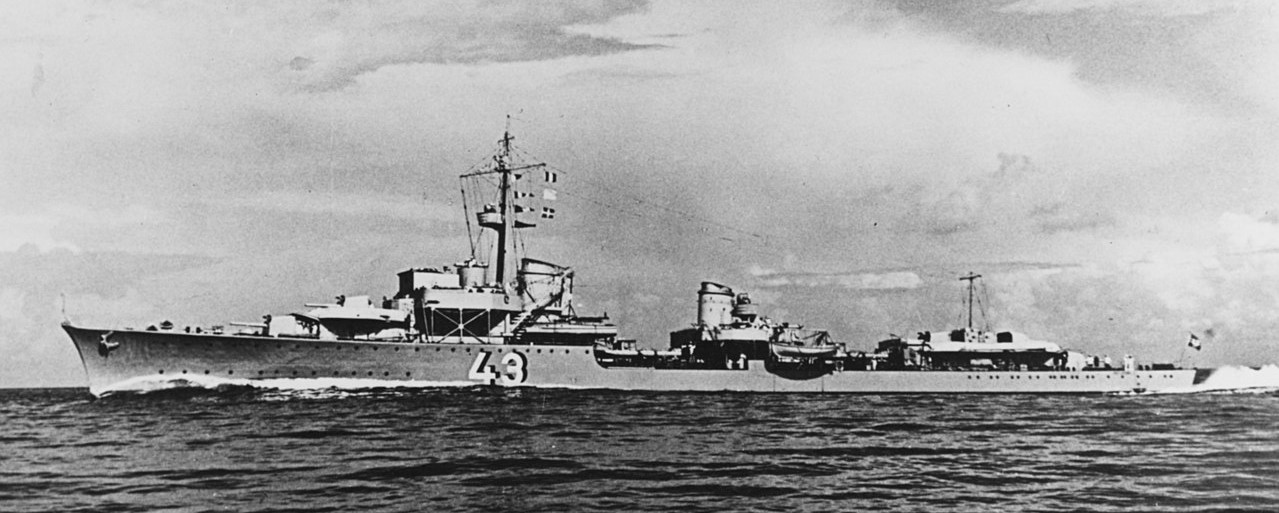
Wilhelm Heidkamp
The snowstorm was heavy enough that those aboard Norge were not aware of the death of their sister ship. It had shielded the other two German destroyers, Arnim and Thiele, when they entered the harbor, preventing Norge from even firing a warning shot. The German vessels managed to grope their way to their target pier, and had begun to disembark troops before the weather cleared enough to reveal them to Norge. Her captain ordered his gunners to open fire, although the snow blinded the rangefinders and none of the shells hit. The destroyers returned fire, and Arnim fired seven torpedoes, aiming carefully between the freighters moored in Narvik harbor. Two of them hit, and Norge proved no more resistant than Eidsvold, with at least one magazine going off almost immediately. Far more crew made it off, at least in part because of rescue efforts from Arnim and the merchant ships nearby. 96 survived, but 105 of her crew perished, along with German hopes for a peaceful occupation. The deaths of nearly 300 men aboard the two vessels galvanized Norwegian resistance like little else that happened that day, particularly within the military.
Heidkamp arrived as the rescue effort continued, and all three destroyers unloaded their troops. They quickly spread out throughout Narvik, and managed to surround the Norwegian troops in town, who were billeted at a local school. The Germans demanded their surrender, and while negotiations were going on, their command ordered them to fight. Realizing that a battle within the town would be bloody, their commander managed to march over 200 men out of the town before the Germans realized what was going on, ready to resist in the surrounding countryside. In the harbor, the British merchant ships destroyed their codebooks, while the German crews sang "Deutschland Uber Alles".
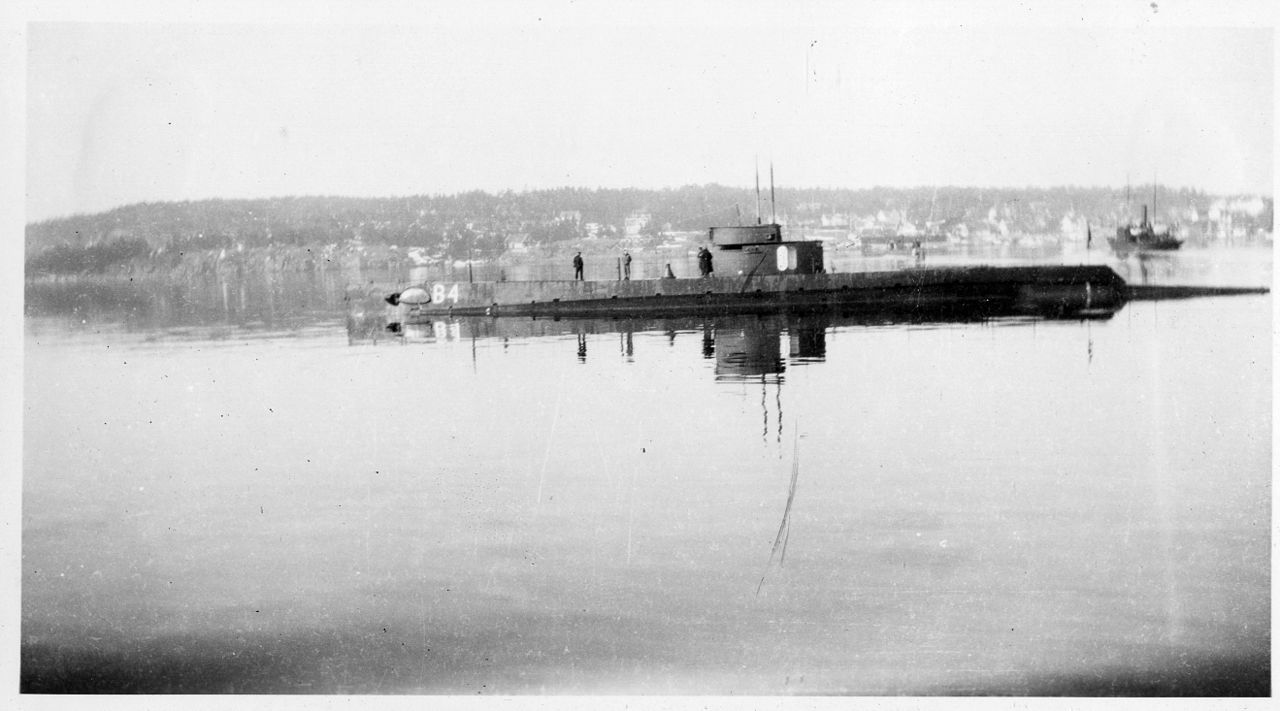
Norwegian submarine B4, sister of the subs in Narvik
The only remaining Norwegian warships in the area were submarines B1 and B3, who had been overlooked during the initial attack, but sortied into the fjord in its aftermath. B3 made an attempt to attack a pair of the destroyers, but they spotted her and she was forced to dive, and her crew battled leaks before breaking for Vestfjorden. B1 likewise had technical problems, and her crew chose to hide her and await further orders.
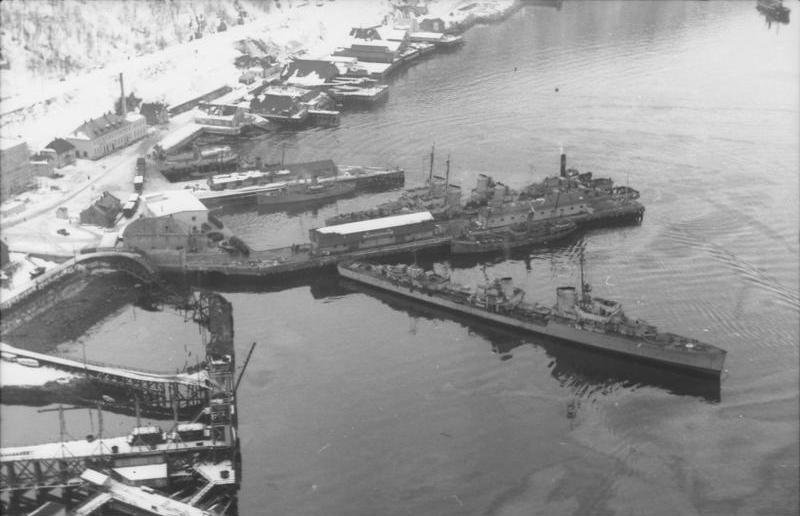
German destroyers in Narvik
But despite their success, the Germans were in a desperate position. All of the artillery they had brought had been washed overboard during the stormy transit from Germany, and the coastal batteries that they had expected to take over were nonexistent. The Norwegians had destroyed the few guns they had in Narvik, so the only guns available were those aboard the British merchant ships, which were hastily taken ashore. More equipment was supposed to be en route aboard three supply ships and two tankers, but only one of the latter had reached Narvik on the 9th, which left the destroyers short on fuel. They would have to rely on the three U-boats in Vestfjorden for protection, or at least to alert them if the British turned up. The only other precaution that the German commander took was to station a single destroyer as a picket, and his orders were unclear enough that the ship had withdrawn by the time the British actually turned up the next morning, an engagement we'll discuss next time.
1 The 10th destroyer had gotten separated during the passage, and was running about 3 hours behind. ⇑

Comments
Being ordered to capture a fortress that doesn't actually exist feels like it would make a great movie.
@Ike, something out of Dad's Army...
Those paper fortresses would have been an awesome piece of misinformation if only it had been done deliberately.
Another famous wording from these initial battles; "nu skal vi slåss, gutter" - "time to fight, boys!" But less successful than Eriksen's "Visst fanden", to be sure.
Typos:
Should be "panserskip", from "panser" meaning armour and "skip", ship.
"Eidsvold".
@Rolf
This is what I get for not running this by you before I put it up. Fixed the typos.
Interesting. I didn't think the survivors heard the original order.
It blows my mind how badly the Allies screwed up in failing in Norway. I understand the desire to prevent the German fleet from getting out into the Atlantic, but after what is coming next, I feel like the Allies should have driven them out or starved them out at some point before VE Day.
Once the Germans have Norway and Denmark, the Baltic is basically an Axis lake. OK, the Russians might disagree with that point, but they couldn't do much more than put an occasional submarine out to sea for the nuisance value. The Germans could reliably ship men and supplies to Norway through shallow coastal waters, and to some extent (i.e. food and medical supplies) using Swedish railways.
So any plan to starve the Germans out, wasn't going to work. The allies would have had to actually land troops. And while the Norwegian coast was longer and less well defended than e.g. France, any troops the allies did put ashore would be a lot farther from anyplace really critical and easier for the Germans to keep isolated.
How would you propose that they do that? Doing anything in the Skager Rack, when your enemy has air bases on both sides, is not conducive to your navy's health and well being. Even if you were some how able to get that to work - despite losses, there is still the option of rail supply from Sweden.
What are subs for? The UK had several dozen submarines that were certainly good enough to sit about the Kattegat taking potshots at passing merchantmen. Germany didn't have that many more to blockade the whole Atlantic, which was both further from their bases and much bigger.
I also note that the British blockaded Norway very successfully in 1809; "the tale's still told / what the people bore..."
@Rolf
That would, indeed, be a dangerous neaucense with modern technology. However, period subs would need to be surfaced almost all of the time. I don't think the British had snorkels until well after the war.
Given the technology of the time, subs were essentially a statistical nuisance. Assuming their torpedoes were working, they were usually good for taking out a percentage of the things they ran into. This is good at whittling down the enemy's merchant fleet, provided you can do it without losing too many submarines in the process, but it's never going to be perfect. The big issue during the Battle of the Atlantic wasn't individual cargoes not getting through, it was that ship losses meant they couldn't handle the necessary volume of cargo. The Skaggerak isn't a place I'd want to try to operate a sub, and the Germans had sufficient shipping to keep the lines to Norway open.
As for 1809, it was a very different time. You could easily park a ship off a port, and so long as it kept out of range of land-based guns, it could effectively blockade the port until a stronger warship showed up. By 1940, this wasn't really feasible, thanks to mines, torpedo boats and aircraft.
Note also that the Germans mined the west end of the Skagerak shortly after invading Norway, with roughly one mine every 14 meters. That, plus patrol craft, plus aircraft, plus shallow water, makes "let's just send submarines to starve the Germans out of Norway" a losing proposition even before the part where, through mid-1943, they could just run everything short of actual munitions through Sweden.